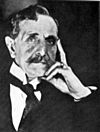Ernesto de la Cárcova facts for kids
Quick facts for kids
Ernesto de la Cárcova
|
|
|---|---|
 |
|
| Born | March 3, 1866 Buenos Aires, Argentina
|
| Died | December 28, 1927 (aged 61) Buenos Aires
|
| Nationality | Argentine |
| Known for | Painter |
|
Notable work
|
Without Bread or Work (1893) |
| Movement | Realist |
| Awards | Gold medal, Universal Exposition of 1904 |
Ernesto de la Cárcova (born March 3, 1866 – died December 28, 1927) was a famous Argentine painter. He was known for his "Realist" style of art. This means he painted things exactly as they looked in real life.
Contents
Early Life and Art Training
Ernesto de la Cárcova was born in Buenos Aires, Argentina, in 1866. From a young age, he loved to paint. He studied art at the Society for the Stimulus of Fine Arts. His teacher there was a painter named Francisco Romero.
Later, Ernesto went to a famous art school in Turin, Italy. It was called the Accademia Albertina. There, he learned from another great painter, Giacomo Grosso.
Important Artworks and Recognition
In 1890, Ernesto showed his drawing The Head of An Old Man in Turin. It was a pastel drawing, which uses special colored sticks. The King of Italy, Umberto I, bought this drawing. He wanted it for his palace in Rome.
After returning to Argentina, Ernesto finished his most famous painting in 1893. It is called Without Bread or Work. This painting shows a difficult time in Buenos Aires. It was during a period when many people lost their jobs. Today, you can see this important artwork at the National Museum of Fine Art.
Teaching and Legacy
Ernesto de la Cárcova became very well-known. In 1902, he was asked to lead a program for Argentine artists in Paris. He also won a gold medal for his art in 1904. This was at a big art show in St. Louis, United States.
While in Europe, he also became interested in sculpture. He bought many copies of ancient sculptures. These included pieces from Ancient Egypt, Chaldea, and Ancient Greece. He brought them back to Buenos Aires.
In 1910, he showed some of these sculptures at the Buenos Aires Centennial Exposition. He was then invited to join the National Fine Arts Academy. This academy was started by another Realist painter, Eduardo Sívori.
Ernesto also became a professor at the University of Buenos Aires. He continued to win awards, like a silver medal at a Paris art show in 1916. His designs were chosen for the official medal of the Argentine Centennial in 1910. He also designed the great seal for the University of Buenos Aires in 1921.
In 1923, he helped start the School Superior of Fine Arts. This school later became part of the National University Art Institute. This is Argentina's most important art school.
After Ernesto de la Cárcova passed away in 1927, his collection of German sculptures was used to create a museum. This museum was named the Ernesto de la Cárcova Museum of Reproductions and Comparative Sculpture in his honor. He was buried in La Recoleta Cemetery.
See also
 In Spanish: Ernesto de la Cárcova para niños
In Spanish: Ernesto de la Cárcova para niños



